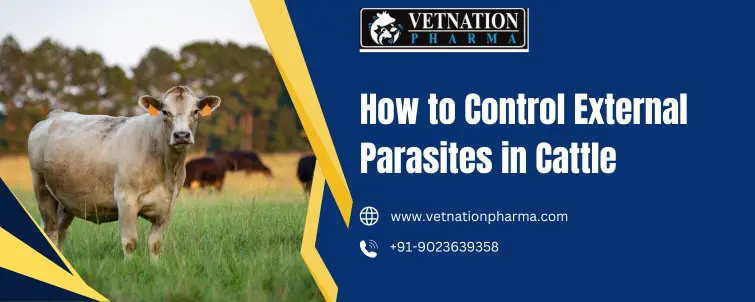- Veterinary PCD & Third Party Manufacturing
- +91-9023639358
- vetnationpharma@gmail.com
How to Control External Parasites in Cattle
How to Control External Parasites in Cattle : Vetnation Pharma
External parasites, such as ticks, lice, mites, and flies, pose a major threat to cattle health, leading to discomfort, disease transmission, and reduced productivity. Controlling these parasites is crucial for maintaining a healthy and productive herd. In this article, we’ll delve into various methods and strategies to effectively manage and control external parasites in cattle.
Understanding External Parasites
Before diving into control measures, it’s important to understand the common external parasites that affect cattle, such as ticks, lice, mites, and flies. Effective control strategies can significantly improve cattle health and productivity.
- Ticks: These arachnids attach to the skin, feeding on blood and potentially transmitting diseases like anaplasmosis and babesiosis.
- Lice: Lice infestations cause itching, irritation, and can lead to anemia in severe cases.
- Mites: These microscopic parasites burrow into the skin, causing mange, which results in hair loss, scabs, and severe itching.
- Flies: Flies, including horn flies, stable flies, and face flies, can cause annoyance, reduce weight gain, and transmit diseases like pinkeye.
Preventative Measures
Prevention is always better than cure when it comes to controlling external parasites in cattle. Here are some key preventative measures to control external parasites in cattle
1. Regular Inspection and Monitoring
Routine inspection of cattle for signs of parasite infestation is essential. Look for symptoms such as excessive scratching, hair loss, scabs, and visible parasites. Early detection allows for prompt treatment and minimizes the spread.
2. Environmental Management
Maintaining a clean and hygienic environment helps reduce parasite habitats. This includes:
- Pasture Management: Rotate grazing areas to prevent overgrazing and reduce parasite exposure.
- Manure Management: Regularly remove manure to decrease breeding sites for flies.
- Shelter Maintenance: Keep barns and shelters clean and dry to deter mites and lice.
3. Biological Control
Introducing natural predators or beneficial insects can help control parasite populations. For example, releasing dung beetles can reduce fly larvae in manure, and predatory wasps can target fly pupae.
Chemical Control Methods
Chemical treatments are often necessary to control external parasites effectively. Various options are available, and it’s important to use them responsibly to avoid resistance. Control External Parasites in Cattle
1. Insecticides and Acaricides
These chemicals can be applied through sprays, pour-ons, dusts, or dips. Commonly used insecticides and acaricides include:
- Pyrethroids: Effective against flies, lice, and ticks.
- Organophosphates: Used for controlling a broad spectrum of parasites.
- Macrocyclic Lactones: Effective against internal and external parasites.
2. Ear Tags
Insecticidal ear tags slowly release insecticide over time, providing long-term protection against flies and ticks. Replace tags as recommended to ensure continued efficacy.
3. Pour-Ons and Spot-Ons
These topical treatments are easy to apply and provide immediate relief from parasites. Follow the manufacturer’s instructions for dosage and application frequency.
Integrated Pest Management (IPM)
An integrated approach combines multiple strategies to control external parasites in cattle effectively and sustainably. IPM focuses on reducing reliance on chemical treatments and incorporating cultural, biological, and mechanical control methods
1. Cultural Control
Implementing good management practices, such as rotational grazing and maintaining optimal herd health through nutrition and stress reduction, can decrease susceptibility to parasites.
2. Biological Control
As mentioned earlier, biological agents like dung beetles and predatory insects can help manage parasite populations naturally.
3. Mechanical Control
Using physical barriers, such as fly traps, back rubbers, and dust bags, can reduce fly and tick infestations. Regular grooming and washing of cattle also help remove parasites and eggs.
Treatment for Parasite Infestations
When prevention isn’t enough, prompt treatment of infestations is critical:
1. Ticks
- Manual Removal: Physically remove ticks using tweezers, ensuring the entire tick is extracted to prevent infection.
- Acaricides: Apply acaricides as sprays or dips to kill ticks on contact.
2. Lice
- Insecticides: Treat lice infestations with insecticidal sprays, dusts, or pour-ons. Repeat treatments as needed to break the life cycle.
3. Mites
- Topical Treatments: Use topical acaricides to treat mange. Ensure thorough coverage to reach mites in the skin.
4. Flies
- Fly Control Products: Use fly sprays, pour-ons, or dusts to control fly populations. Implement fly control measures in the environment, such as fly traps and manure management.

Conclusion
Control External Parasites in Cattle: Controlling external parasites in cattle is essential for maintaining herd health, productivity, and overall welfare. By implementing a combination of preventative measures, chemical treatments, and integrated pest management strategies, you can effectively manage and reduce the impact of external parasites on your cattle. Regular monitoring, environmental management, and timely treatment are key to keeping your herd healthy and thriving
Contact Information
Contact Vetnation Pharma if you want to know How to Control External Parasites in Cattle or any other part of PAN India.
- Company Name: Vetnation Pharma
- Company Address: Plot no 295, Industrial area phase -2, Panchkula- 134 109, Haryana (India)
- Contact us: +91- 90236 39358
- Website: www.vetnationpharma.com/
- Write us: vetnationpharma@gmail.com
FAQ:
- Q: What methods are effective for Control External Parasites in Cattle?
A: Effective methods include using parasiticides like sprays or dips, practicing pasture management techniques, and maintaining clean feeding areas. - Q: How can I manage external parasites through pasture management?
A: Rotate grazing areas and allow pastures to rest periodically to break the parasite life cycle and reduce exposure for cattle. - Q: Why is maintaining hygiene important in Control External Parasites in Cattle?
A: Clean feeding and watering areas help minimize contact with parasites, reducing the risk of infestation among cattle. - Q: When should I treat cattle for Control External Parasites in Cattle?
A: Regularly inspect cattle for signs of parasites and treat promptly to prevent infestations from spreading and affecting herd health.
